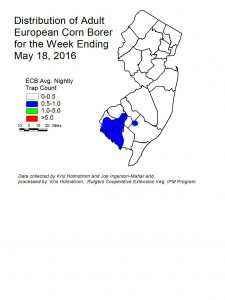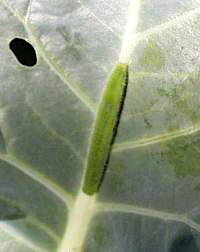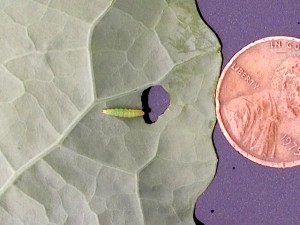Sweet Corn
A few European corn borer (ECB) adults are being captured now, despite cool conditions. At the present, areas of highest activity include Cumberland, Gloucester and Salem counties (see ECB map), although scattered individuals have been captured as far north as Morris County. Cooler nights for the rest of this week may suppress catches for the next several days. Most early sweet corn plantings are too young to support ECB larval infestations. However, over the next three weeks we should begin to see feeding in the most advanced plantings. Be sure to begin monitoring the earliest plantings for ECB feeding while they are still in the whorl stage.
The highest nightly ECB catches for the previous week are as follows:
| Beckett 1 | Folsom 1 |
| Belvidere 1 | Jones Island 1 |
| Denville 1 | Long Valley 1 |
| Downer 1 | Woodstown 1 |
Tomatoes
Aphid populations have begin to appear in high tunnel tomatoes. These pests often form colonies beneath the surface of leaves and near growing points on the plant. While the plants consist primarily of vegetative growth without fruit, aphids are largely an insignificant pest. If no broad spectrum insecticides are used on the plants, the aphids generally are decimated by predators and parasites before becoming an economic problem. Recently discovered colonies also contained eggs of syrphid (flower) flies. Maggots will emerge from these eggs and will begin to prey on aphids. Should aphid populations increase to a degree that their droppings are accumulating on the surface of developing fruit, an insecticide that specifically targets these pests may be necessary. See the 2016 Commercial Vegetable Production Recommendations for materials that are labeled for aphid control in tomatoes. Avoid broad spectrum insecticide classes such as synthetic pyrethroids as much as possible.
Pepper Weevil
We are tracking pepper weevil at or near three processing facilities in southern NJ. Traps were set in April and so far no weevils have been caught.
Cole Crops
Imported cabbage worm (ICW) (see photo at left) infestations have been largely absent, owing to the cold spring we are experiencing. As the weather warms, scout plantings weekly. Check 5 consecutive plants each in 10 random locations throughout the planting, paying particular attention to the innermost leaves where ICW often feed. Consider treating if caterpillars are found on 10% or more plants that are in the 0-9 true leaf stage. From 9-leaf to the early head stage (in broccoli, cauliflower and cabbage) infestations up to 20% may be tolerated. Once heads begin to form, a 5% threshold should be observed to protect the marketable portion of the plant. For leafy greens such as collards and kale, 10% plants infested is the threshold throughout.
Although none have been discovered yet, it is not too soon to begin preparing for infestations of diamondback moth (DBM) larvae (see photo above right). Some populations of DBM are resistant to carbamate and synthetic pyrethroid insecticides. The lack of DBM control with these insecticides has been noted in NJ previously. It is important to distinguish between common cole crop pests for this reason. DBM larvae grow to a length of approximately 0.5”, and taper toward both ends. These caterpillars thrash violently when disturbed. ICW grow to a length of approximately 1.25” and are covered with short hairs. Newer chemistries that specifically target caterpillar pests are effective against DBM as well as all other caterpillar pests of cole crops. These materials include (active ingredient – trade name (IRAC* code)):
Spinosad/Spinetoram – Entrust/ Radiant (5)
Chlorantraniliprole – Coragen (28)
Cyantraniliprole – Exirel (28)
The IRAC group 5 insecticide, Entrust, is OMRI approved for organic production. Insecticides based on the soil inhabiting bacterium Bacilllus thuriengensis (B.t.) may also be effective on caterpillar pests of cole crops. Examples include Xentari and Javelin. These materials are also OMRI approved. If B.t. materials are used, they must target smaller larvae. Do not wait until large larvae are dominant the field, as results may be unsatisfactory. An added benefit of all the aforementioned chemicals is that they have minimal impact on non-target species, including many insect predators and parasites. Spinosad materials should be used in a way that avoids contact with bees.
*Insecticide Resistance Action Committee




